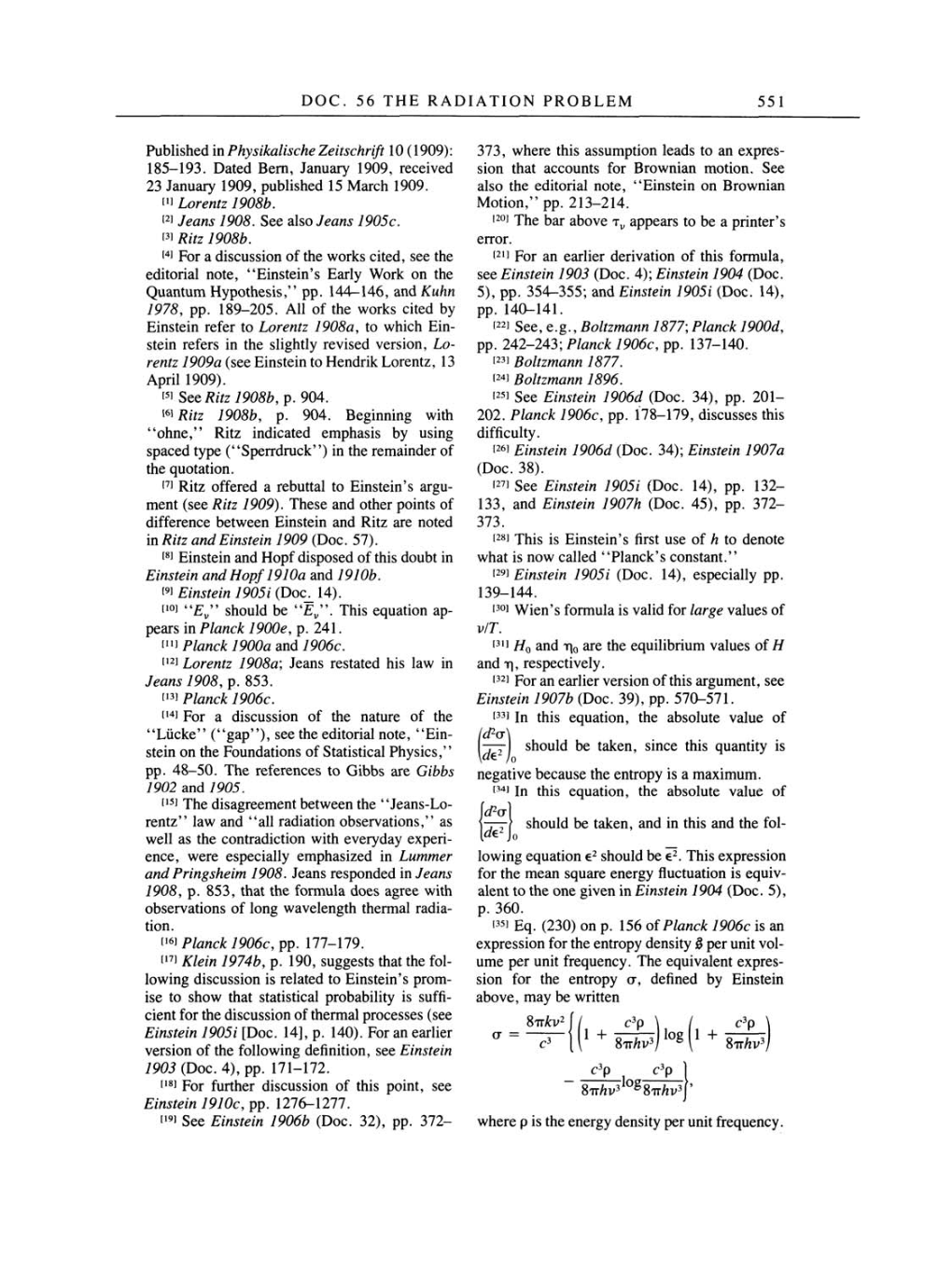DOC. 56 THE RADIATION PROBLEM 551
Published in
Physikalische
Zeitschrift
10 (1909):
185-193.
Dated
Bern,
January
1909,
received
23
January
1909,
published
15
March 1909.
[1]
Lorentz 1908b.
[2]
Jeans
1908. See also
Jeans
1905c.
[3]
Ritz 1908b.
[4]
For
a
discussion
of
the works
cited,
see
the
editorial note,
"Einstein's
Early
Work
on
the
Quantum Hypothesis," pp.
144-146, and Kuhn
1978,
pp.
189-205.
All
of
the works cited
by
Einstein
refer
to
Lorentz 1908a,
to
which
Ein-
stein refers in the
slightly
revised version, Lo-
rentz
1909a
(see
Einstein
to
Hendrik
Lorentz, 13
April
1909).
[5]
See Ritz
1908b,
p.
904.
[6]
Ritz
1908b,
p.
904.
Beginning
with
"ohne,"
Ritz indicated
emphasis by using
spaced type
("Sperrdruck")
in the remainder
of
the
quotation.
[7]
Ritz offered
a
rebuttal to
Einstein's
argu-
ment
(see
Ritz
1909).
These and other
points
of
difference between Einstein and Ritz
are
noted
in Ritz
and
Einstein 1909
(Doc. 57).
[8]
Einstein and Hopf
disposed
of
this
doubt in
Einstein and
Hopf 1910a and 1910b.
[9]
Einstein
1905i
(Doc. 14).
[10] "Ev"
should be "Ev".
This
equation ap-
pears
in
Planck
1900e, p.
241.
[11]
Planck
1900a and 1906c.
[12]
Lorentz
1908a;
Jeans restated his law in
Jeans
1908, p.
853.
[13]
Planck
1906c.
[14]
For
a
discussion
of
the
nature
of
the
"Lücke"
("gap"),
see
the editorial
note,
"Ein-
stein
on
the Foundations
of
Statistical
Physics,"
pp.
48-50. The
references
to Gibbs
are
Gibbs
1902 and 1905.
[15]
The
disagreement
between the
"Jeans-Lo-
rentz"
law and
"all
radiation observations,"
as
well
as
the contradiction with
everyday experi-
ence,
were especially emphasized
in Lummer
and
Pringsheim 1908. Jeans
responded
in
Jeans
1908,
p.
853,
that
the
formula
does
agree
with
observations
of
long wavelength
thermal radia-
tion.
[16]
Planck
1906c, pp.
177-179.
[17]
Klein
1974b,
p.
190, suggests
that
the fol-
lowing
discussion
is
related
to
Einstein's
prom-
ise
to
show that statistical
probability
is
suffi-
cient
for the discussion
of
thermal
processes
(see
Einstein
1905i
[Doc. 14],
p.
140).
For
an
earlier
version
of
the
following
definition,
see
Einstein
1903
(Doc.
4),
pp.
171-172.
[18]
For further discussion
of
this
point, see
Einstein
1910c,
pp.
1276-1277.
[19]
See
Einstein
1906b
(Doc. 32),
pp.
372-
373,
where this
assumption
leads
to
an expres-
sion that
accounts
for Brownian motion. See
also the editorial
note,
"Einstein
on
Brownian
Motion,"
pp.
213-214.
[20]
The
bar
above
tv appears
to
be
a
printer's
error.
[21]
For
an
earlier derivation
of
this
formula,
see
Einstein
1903
(Doc. 4);
Einstein 1904
(Doc.
5), pp.
354-355; and Einstein 1905i
(Doc. 14),
pp.
140-141.
[22] See, e.g.,
Boltzmann
1877;
Planck
1900d,
pp.
242-243;
Planck
1906c, pp.
137-140.
[23]
Boltzmann 1877.
[24]
Boltzmann 1896.
[25]
See Einstein 1906d
(Doc. 34),
pp.
201-
202.
Planck
1906c,
pp.
178-179, discusses this
difficulty.
[26]
Einstein 1906d
(Doc. 34);
Einstein 1907a
(Doc. 38).
[27]
See Einstein 1905i
(Doc. 14),
pp.
132-
133,
and Einstein 1907h
(Doc. 45),
pp.
372-
373.
[28]
This is
Einstein's
first
use
of
h
to denote
what
is
now
called
"Planck's constant."
[29]
Einstein 1905i
(Doc. 14), especially pp.
139-144.
[30]
Wien's
formula
is
valid for
large
values
of
vlT.
[31]
H0
and
n0
are
the
equilibrium
values
of
H
and
n,
respectively.
[32]
For
an
earlier
version
of
this
argument, see
Einstein
1907b
(Doc. 39),
pp.
570-571.
[33]
In this
equation,
the absolute value
of
'cPJ\
should be
taken,
since this
quantity
is
negative
because
the
entropy
is
a
maximum.
[34]
In this
equation,
the absolute value
of
-rrr
should be
taken,
and in this and the fol-
lowing equation e2
should
be
e2.
This
expression
for
the
mean
square energy
fluctuation
is equiv-
alent
to
the
one given
in Einstein 1904
(Doc. 5),
p.
360.
fife-J
o
[35] Eq. (230) on p.
156
of
Planck
1906c is
an
expression
for the
entropy density
8
per
unit
vol-
ume
per
unit
frequency.
The
equivalent
expres-
sion for the
entropy
a,
defined
by
Einstein
above,
may
be written
8irkv2
f
a
=
cJp
3 H1
+
S^v3)108!1
+
8^v3)
c3p c3p
8uhv3^0^8irhv3
where
p
is
the
energy density per
unit
frequency.
